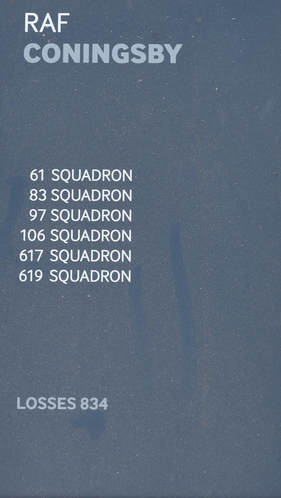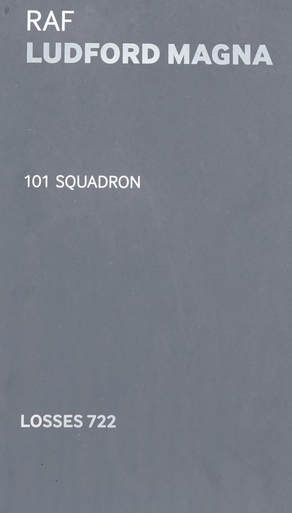International Bomber Command Centre
Lincoln
On 1 April 2018, the Royal Air Force celebrated one hundred years since its formation in 1918 as an Independent Force. Eighteen years later, in 1936, Bomber Command was formed, and within three short years, its 23 squadrons were taking the fight to Hitler's Third Reich. Bomber Command was in action from the first day of the war and for over five and a half gruelling years before peace once again returned to Europe. In that time, 55,573 Bomber Command crew were lost, an attrition rate second only to the German U-Boat crews. It is fair to say the Command's personnel never got the recognition they deserved for the sacrifices made. In part, the benefit of hindsight allowed some to incorrectly question the validity and morality of the bombing campaign waged throughout the war.
The Command's Commander in Chief (C in C), Sir Arthur Harris, who for many years had held the view that Germany could be defeated by bombing alone, was in the later stages of the war increasingly coming into conflict with Winston Churchill. However, the German will to fight remained unbroken, and their industrial output was not significantly weakened. The bombing of Dresden in February 1945, which both Churchill and the Russians requested, resulted in a considerable loss of civilian life. When once known, Churchill distanced himself from Bomber Command even though they were following his desire to assist the Russians. This dealt a fatal blow to the Command from which it never recovered and has tainted Harris's Old Lags, unfairly, for many decades since. At the war's conclusion, no campaign medal was struck for the Command. This omission was perceived as a snub by their C in C Sir Arthur Harris, who refused a peerage in response. It is safe to say that it is only in recent years that the Command's personnel have started to get the respect they so richly deserve.
The Command's Commander in Chief (C in C), Sir Arthur Harris, who for many years had held the view that Germany could be defeated by bombing alone, was in the later stages of the war increasingly coming into conflict with Winston Churchill. However, the German will to fight remained unbroken, and their industrial output was not significantly weakened. The bombing of Dresden in February 1945, which both Churchill and the Russians requested, resulted in a considerable loss of civilian life. When once known, Churchill distanced himself from Bomber Command even though they were following his desire to assist the Russians. This dealt a fatal blow to the Command from which it never recovered and has tainted Harris's Old Lags, unfairly, for many decades since. At the war's conclusion, no campaign medal was struck for the Command. This omission was perceived as a snub by their C in C Sir Arthur Harris, who refused a peerage in response. It is safe to say that it is only in recent years that the Command's personnel have started to get the respect they so richly deserve.
|
In May 2013, a project was launched to remember and honour those who served in Bomber Command in the Second World War, culminating in the official opening of the International Bomber Command Centre (IBCC) in Lincoln on 12th April 2018.
The event included attendance by surviving Bomber Command veterans who at last saw recognition of their service many decades past, even though they are all well into their nineties. |
The event included attendance by surviving Bomber Command veterans who at last saw recognition of their service many decades past, even though they are all well into their nineties.
Regrettably, it has taken so many decades to get deserved recognition, but the Memorial in Hyde Park and the IBCC have gone some way to redress the injustice. Finally, at least some veterans have got to see an appreciation of their service that helped to keep this country free.
Regrettably, it has taken so many decades to get deserved recognition, but the Memorial in Hyde Park and the IBCC have gone some way to redress the injustice. Finally, at least some veterans have got to see an appreciation of their service that helped to keep this country free.
Origins of the IBCC
"You think of these things, and usually people are not interested, but it seems with this one they were".
These are the words of the late Tony Worth, whose vision and determination in creating a lasting memorial to those who served and were lost while operating with Bomber Command in the Second World War is what we see at the IBCC today.
These are the words of the late Tony Worth, whose vision and determination in creating a lasting memorial to those who served and were lost while operating with Bomber Command in the Second World War is what we see at the IBCC today.
Location
|
Lincolnshire has long been known as Bomber County because of the many airfields built within its boundaries that contributed to the RAF's bombing campaign over Occupied Europe in the Second World War.
The IBCC is located on Canwick Hill, which commands dramatic views over the City Of Lincoln. Very prominent on the skyline is Lincoln Cathedral, for many bomber crews a landmark that they would be looking for on their return from operations, for others, one of the last sights they would ever see of England. |
The Memorial Spire
Set at a height of 102 feet (31.09m), the Memorial Spire is the same length as an Avro Lancaster bombers wingspan, an aircraft with a deep association with Lincolnshire. The Memorial is designed to celebrate the connection between sky and earth while signifying the destruction of war through the fragmented wing forms of the central spire.
The structure is 16 feet (5m) wide at its base, the same as a Lancasters wing root. The Memorial is constructed from Corten 'weathering' steel and weighs 55 tons. It has the distinction of being the UK's highest war memorial and was built in two sections, with erection taking place on 10th May 2015.
The structure is 16 feet (5m) wide at its base, the same as a Lancasters wing root. The Memorial is constructed from Corten 'weathering' steel and weighs 55 tons. It has the distinction of being the UK's highest war memorial and was built in two sections, with erection taking place on 10th May 2015.
The Memorial Walls
|
Surrounding the base of the Memorial Spire, 270 panels manufactured from Corten steel make up the 23 walls which list the names of all those lost whilst serving with Bomber Command, nearly 58,000, in the Second World War. These were drawn from the Centre's Losses Database, which is the only place in the World where the losses are commemorated together. It is not the only aircrew listed but all those lost, including ground crew, passengers, SOE agents, cadets, meteorologists and scientists.
|
Each name is laser cut on the panels, where there is duplication, and the same name appears; the last digits of the person's service number is given to help relatives identify their loved ones. All panels are numbered to aid the location of names and are designed to allow poppies to be placed as a mark of remembrance. The panels are clustered in such a way as to group together those lost while based in Lincolnshire and those serving elsewhere in the Command. The names list no rank, medals or awards and all those lost are treated as equals.
The Peace Gardens
|
There are two Peace Gardens set within ten acres of land at the IBCC. The one nearest the Spire is the Lincolnshire Peace Garden, in which 27 native lime trees have been planted to represent the airfields from where the Commands aircraft operated.
The second, the International Peace Garden, commemorates the 62 nations who took part within Bomber Command and the 5 continents from where individuals were drawn. |
The Chadwick Centre
|
As visitors arrive at the IBCC, they will first enter the Chadwick Centre, named after Roy Chadwick, the designer of the Avro Lancaster.
The Centre houses the IBCC's cafe, ticketing facilities, reception, exhibition, and shop. The building is designed to echo the wing shape of a heavy bomber, and its contents tell the story of all those who served in Bomber Command throughout the dark years of World War Two. Entry to the Spire and Gardens is free of charge. However, there is a fee to view the exhibition, details of which can be found by following the link to the IBCC's website below. |
Veterans Stories - https://internationalbcc.co.uk/history-archive/veterans-memories
The Volunteers
As is the case with many such ventures, the IBCC would not be possible without the work and dedication of its volunteers. From staffing the Centre during opening hours to the ongoing research into crews lost, guiding the public and maintaining the grounds, their help is paramount to the IBCC's continued operation and success.
The Station Trees
Twenty-seven lime trees have been planted to commemorate the bases from which Bomber Command aircraft flew in Lincolnshire. The following photographs show each bases squadrons and their losses.





































